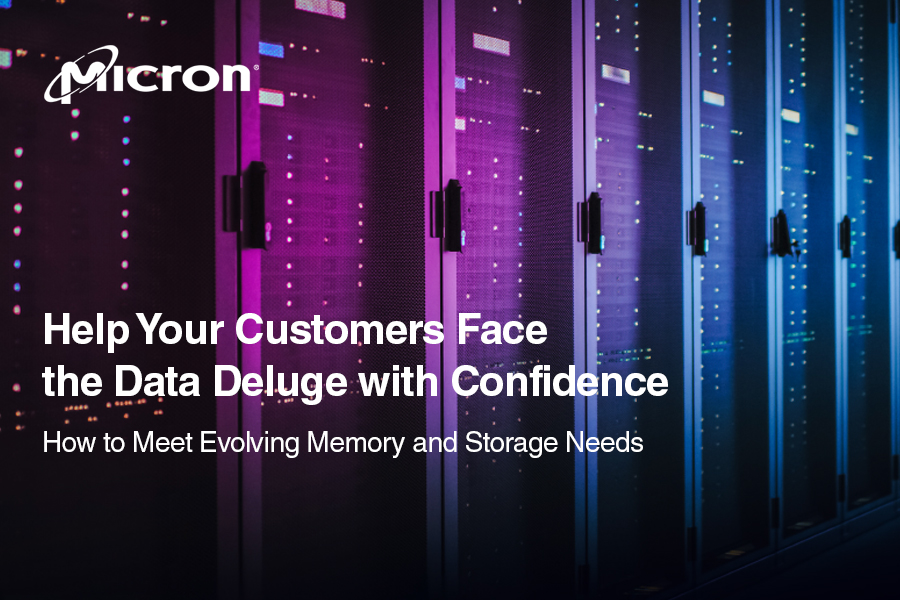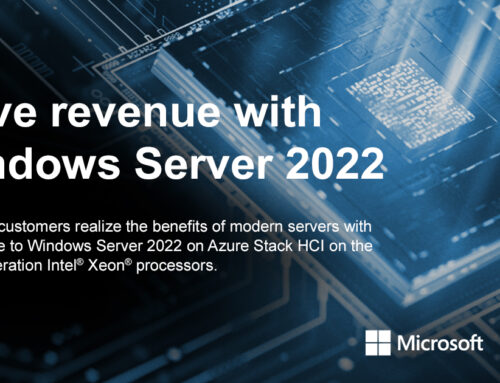The World is Changing. Fast.
These days consumers order groceries online, stream new movie releases from their couch and commute a few steps to another room in their house to work on their laptops. As the world becomes increasingly more digital, the amount of data generated now is practically unfathomable. By 2025, global data creation is predicted to reach 463 exabytes daily.1 This is an exponential increase from the estimated total of 44 zettabytes of 2020.2
But your customers can do more than just prepare to withstand the data deluge. With the right flexible, scalable memory and storage infrastructure in place, they can leverage this data to make smart business decisions and capture actionable, insightful intelligence.
The Problem: The Data Deluge is Changing Almost Every Industry
What is the “Data Deluge”? It’s an industry term for the increasing amount of data in the world. Think of it as a flood of information that you can prepare for in advance.
Data can get out of hand quickly. As of 2020, 70 percent of data decision makers report gathering data faster than they can analyze it.3 But opting to limit data storage is likely not the right decision, either.
Many companies have integrated advanced systems that rely on data to fuel and train them, such as artificial intelligence (AI) and machine learning (ML). If your customer plans on leveraging AI and/or ML, then cutting back on data now might make it necessary to reassess or even reconfigure memory and storage infrastructure too quickly.
In other words: no data is bad data. But businesses need to know how to use the information they gather.
AI and ML Are Adding Complexity
The data deluge is amplified by the rise of AI and ML and complicated by hybrid infrastructures that combine cloud and on-premise server systems. As more industries integrate these technologies, they create even more data. On average, businesses with high-performing AI store twice as much data in their data pipeline (1145TB vs. 537TB) and data lakes (1075TB vs. 516TB) than other organizations.4
Moreover, customers who might’ve once shied away from raising budgets or transforming traditional business might now be seeing the need to innovate alongside experts that understand the data deluge. A recent survey found that organizations look to partners for help managing and implementing an infrastructure that supports AI/ML.5
The Solution: Flexible, Scalable Memory and Storage
AI demands a new generation of faster, more flexible global infrastructures. The innate parallelism of AI architectures places a greater burden on memory and storage design and performance than ever before.
The good news: Memory and storage solutions are evolving to keep pace with big data and the next-generation technology that leverages it. Consider these needs when building out your customer’s infrastructure:
- Collection
AI processes depend on massive amounts of data. This size can vary, and the data is often in unstructured object or file formats such as videos, images or documents. This data collection requires scalable storage capacity like quad-level cell (QLC) SSDs built with NAND memory that can offer a balance between capacity, speed and cost. - Processing
Data must be filtered, distilled and efficiently organized to be useful — a problem solved by central processing units (CPU), adding accelerators and graphics processing units (GPU) in a composable data center infrastructure and supported by server DRAM, allowing some AI workloads, like huge datasets, to be shifted to dedicated hardware. This step can temporarily hold data while it’s being preprocessed and feed it rapidly to the processor. NVMe SSDs can store the data once it is processed and becomes structured so it can be used for AI training. - AI Training
This training is extremely resource-intensive: It requires passing pieces of data through the training system hundreds or thousands of times and regularly retraining as new data flows in. Therefore, this process needs powerful, flexible data centers that can support high bandwidth memory repeatedly feeding data at super-high speeds to the GPU or CPU to create the AI algorithm’s logical connections. - Execution
Typically, as the trained AI model is inferring (making predictions), enterprises must continually evaluate its accuracy. The resulting trend or feedback analysis is usually part of an analytics process that uses data captured by devices and inference results. Although specifications depend on the use case, memory that provides a good balance of high performance and low power consumption can be ideal when executing inference on small remote or mobile devices.
Integrate the Future of Memory and Storage — Alongside an Industry Leader
Micron memory and storage have been foundational in AI’s transformation into highly adaptable self-training and ubiquitous ML systems. Micron’s fast, vast storage and high-performance, high-capacity solutions power AI/ML training and inference engines at scale, whether in the cloud or embedded in mobile and edge devices.
Contact your ASI Sales Rep today to learn more about how Micron products and solutions can help you stay ahead.
This blog article is sponsored by Micron.
- Jeff Desjardins, “World Economic Forum – How much data is generated each day?” Visual Capitalist, April 17, 2019 (accessed September 15, 2021).
- Jeff Desjardins, “World Economic Forum – How much data is generated each day?” Visual Capitalist, April 17, 2019 (accessed September 15, 2021).
- “Overcome Data Challenges With Data-As-A-Service,” Forrester Consulting, May 2021 (accessed October 20, 2021).
- ESG Research, AI/ML Storage Trends, September/October 2020 (accessed September 15, 2021).
- ESG Research, AI/ML Storage Trends, September/October 2020 (accessed September 15, 2021).






Leave A Comment